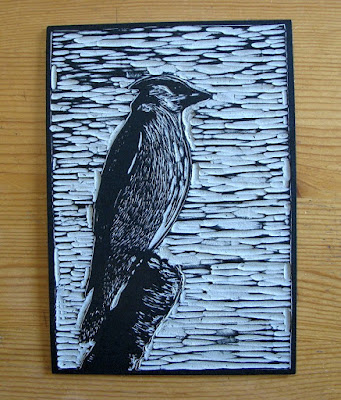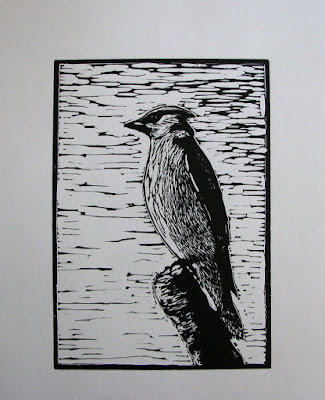
styrofoam jigsaw relief print on black paper
I will be starting a project on Monday working with about 20 elementary school students (range of grade levels from four through eight). They will be creating individual relief based prints from the surface of a product called scratchfoam. The students will be learning a technique called jigsaw block. They first draw an image into the surface of the foam using ballpoint pen. Then waterbased ink is rolled onto the print surface using a rubber brayer and printed using a hand burnishing application onto a piece of paper that is set over top.
The foam is first bonded to a thin piece of bristol board using a high tack spray adhesive. The bristol board has a thin layer of water based varathane rolled on the bottom side to help waterproof it and to counter act the tension of the two materials brought together. This prevents it from curling when it is cut apart or when ink is applied to the surface. This sandwich thickness is still pretty easy to cut using scissors.
The next step is to dissect the block which will allow it to be printing using a jigsaw technique.
I carefully cut the block apart using scissors and xacto blades. The trick was to follow lines already drawn into the foam and use these as a cutting guide .

I devised a registration board system so that a 9 x 12 inch piece of scratchfoam was reduced to a 7 x 10 inch block. This left 1 inch strips of scratchfoam which were set along the edge of a 9 x 12 foamcore registration board and held in place with masking tape. The inked pieces were reassembled back into this frame. Each of the 7 individual segments had a colour of ink rolled on and were then reassembled A 9 x 12 piece of black paper was placed over the block and held in place with push pins at top. The placement of the block contained within the one inch strips along the perimeter helped to center the block on the paper and left a one inch border around the image on the paper.
I found that Speedball ink has a tendency to dry quickly (even with retarder medium added) so had apply a spray of very fine water mist to reactivate it just before the paper was set over top and hand burnished.I usually spray about 15 - 20 inches above the block and let the mist settle gently and evenly on the surface. Unfortunately a little bit more water collected and caused a little uneveness in the light blue section under the crow and to the left side of the trash can. Anyhow those that work with Speedball might understand some of the challenges it presents.
I chose black paper as it provides the dark contrast to define the line in a positive image. If this was printed onto white paper then you would get a neg. image.The students should have some fun with this testing their skills in composition, colour application and exploration of shape, line, texture to name but a few key learning factors.
Another thing I have learned is that some of the Speedball inks such as yellow, red and blue do not print as opaque on a black background so by adding just a hint of white ink will help to increase the opacity. But in some cases the transparency factor can be used for effect (for example a pure yellow was printed on to the black paper in the grass section at the bottom of this image and produced a tint of green).
If I were to do an edition of prints from the foam block for my own collection (which I may still) would most likely would use an oil based ink and print these on a better quality of printmaking paper that is available in black such as Stonehenge, Somerset or Canson paper.
If I were to do an edition of prints from the foam block for my own collection (which I may still) would most likely would use an oil based ink and print these on a better quality of printmaking paper that is available in black such as Stonehenge, Somerset or Canson paper.

















.jpg)


.jpg)


























